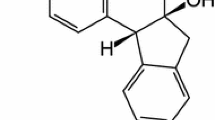Abstract
Zwitterions formed from the addition of triphenylphosphine to dialky acetylene-dicarboxylates attack the nucleus of both 1H-perimidine (1) and 1H-benzo[d]imidazole (9) to form novel pyrido[1,2,3-cd]perimidine and imidazo[4,5,1-ij]quinoline derivatives in moderate yields (64–72%). The biological activity of the products has been studied. Compound 3a was found to extend life span of wild type Caenorhabditis elegans under standard laboratory conditions. Both heat stress and induced chemical stress resistance of wild type C. elegans were improved in a reverse dose-dependent manner due to 3a treatment. In addition, treatment of worms with compound 3a significantly attenuated the formation of advanced glycation end products in a reverse dose-dependent manner.
Similar content being viewed by others
References
Aly, A. A. and El-Shaieb, K. M., Reaction of 1,8-diaminonaphthalene with some selected π-acceptors; prospective optically active non-linear cyanovinylated naphthalenes as well as synthesis of novel perimidin and pleiadene derivatives. Tetrahedron, 60, 3797–3802 (2004).
Bendich, A., Physiological role of antioxidants in the immune system. J. Dairy Sci., 76, 2789–2794 (1993).
Brenner, S., The genetics of Caenorhabditis elegans. Genetics, 77, 71–94 (1974).
Doonan, R., McElwee, J. J., Matthijssens, F., Walker, G. A., Houthoofd, K., Back, P., Matscheski, A., Vanfleteren, J. R., and Gems, D., Against the oxidative damage theory of aging: superoxide dismutases protect against oxidative stress but have little or no effect on life span in Caenorhabditis elegans. Genes Dev., 22, 3236–3241 (2008).
El-Shaieb, K. M., Shaker, R. M., and Aly, A. A., A Facile Route to the Synthesis of New 2,3-Disubstituted Benzocoumarins. Synthetic Commun., 38, 2054–2060 (2008).
Finkel, T. and Holbrook, N. J., Oxidants, oxidative stress and the biology of ageing. Nature, 408, 239–247 (2000).
Glenn, C. F., Chow, D. K., David, L., Cooke, C. A., Gami, M. S., Iser, W. B., Hanselman, K. B., Goldberg, I. G., and Wolkow, C. A., Behavioral deficits during early stages of aging in Caenorhabditis elegans result from locomotory deficits possibly linked to muscle frailty. J. Gerontol. A Biol. Sci. Med. Sci., 59, 1251–1260 (2004).
Guarente, L. and Kenyon, C., Genetic pathways that regulate ageing in model organisms. Nature, 408, 255–262 (2000).
Harman, D., The aging process. Proc. Natl. Acad. Sci. U. S. A., 78, 7124–7128 (1981).
Heidler, T., Hartwig, K., and Hannelore, D., Caenorhabditis elegans lifespan extension caused by treatment with an orally active ROS-generator is dependent on DAF-16 and SIR-2.1. Biogerontology, 11, 183–195 (2010).
Herndon, L. A., Schmeissner, P. J., Dudaronek, J. M., Brown, P. A., Listner, K. M., Sakano, Y., Paupard, M. C., Hall, D. H., and Driscoll, M., Stochastic and genetic factors influence tissue-specific decline in ageing C. elegans. Nature, 419, 808–814 (2002).
Lakowski, B. and Hekimi, S., The genetics of caloric restriction in Caenorhabditis elegans. Proc. Natl. Acad. Sci. U. S. A., 95, 13091–13096 (1998).
Larsen, P. L., Aging and resistance to oxidative damage in Caenorhabditis elegans. Proc. Natl. Acad. Sci. U. S. A., 90, 8905–8909 (1993).
Machlin, L. J. and Bendich, A., Free radical tissue damage: protective role of antioxidant nutrients. FASEB J., 1, 441–445 (1987).
Morcos, M., Du, X., Pfisterer, F., Hutter, H., Sayed, A. A., Thornalley, P., Ahmed, N., Baynes, J., Thorpe, S., Kukudov, G., Schlotterer, A., Bozorgmehr, F., Abd El Baki, R., Stern, D., Moehrlen, F., Ibrahim, Y., Oikonomou, D., Hamann, A., Becker, C., Zeier, M., Schwenger, V., Miftari, N., Humpert, P., Hammes, H. P., Buechler, M., Bierhaus, A., Brownlee, M., and Nawroth, P. P., Glyoxalase-1 prevents mitochondrial protein modification and enhances lifespan in Caenorhabditis elegans. Aging Cell, 7, 260–269 (2008).
Sayed, A. A. R., Ferulsinaic acid attenuation of AGEs extends life span of Caenorhabditis elegans. J. Pharm. Pharmacol., 63, 423–428 (2011).
Sayed, A. A., Thymoquinone and proanthocyanidin attenuation of diabetic nephropathy in rats. Eur. Rev. Med. Pharmacol. Sci., 2011 (in press).
Schlotterer, A., Kukudov, G., Bozorgmehr, F., Hutter, H., Du, X., Oikonomou, D., Ibrahim, Y., Pfisterer, F., Rabbani, N., Thornalley, P., Sayed, A., Fleming, T., Humpert, P., Schwenger, V., Zeier, M., Hamann, A., Stern, D., Brownlee, M., Bierhaus, A., Nawroth, P., and Morcos, M., C. elegans as model for the study of high glucose-mediated life span reduction. Diabetes, 58, 2450–2456 (2009).
Scoggins, C. H., The cellular basis of aging. West J. Med., 135, 521–525 (1981).
Van Raamsdonk, J. M. and Hekimi, S., Deletion of the mitochondrial superoxide dismutase sod-2 extends lifespan in Caenorhabditis elegans. PLoS Genet., 5, e1000361 (2009).
Wagner, E. C. and Millett, W. H., Benzimidazole. Org. Synth. Coll., Vol. 2, 65 (1943).
Wagner, Z., Wittmann, I., Mazak, I., Schinzel, R., Heidland, A., Kientsch-Engel, R., and Nagy, J., N(epsilon)-(carboxymethyl) lysine levels in patients with type 2 diabetes: role of renal function. Am. J. Kidney Dis., 38,785–791 (2001).
Wilson, M. A., Shukitt-Hale, B., Kalt, W., Ingram, D. K., Joseph, J. A., and Wolkow, C. A., Blueberry polyphenols increase lifespan and thermotolerance in Caenorhabditis elegans. Aging Cell, 5, 59–68 (2006).
Zhang, L., Guoliang, J., Junjing, Z., and Baolu, Z., Significant longevity-extending effects of EGCG on Caenorhabditis elegans under stress. Free Radic. Biol. Med., 46, 414–421 (2009).
Author information
Authors and Affiliations
Corresponding author
Rights and permissions
About this article
Cite this article
Sayed, A.A.R., El-Shaieb, K.M. & Mourad, AF.E. Life span extension of Caenorhabditis elegans by novel pyridoperimidine derivative. Arch. Pharm. Res. 35, 69–76 (2012). https://doi.org/10.1007/s12272-012-0107-x
Received:
Revised:
Accepted:
Published:
Issue Date:
DOI: https://doi.org/10.1007/s12272-012-0107-x




